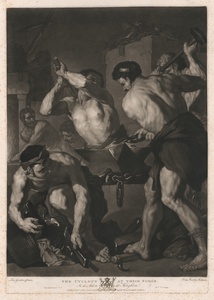| Method | Mezzotint |
| Artist | John Murphy after Luca Giordano |
| Published | Luca Giordano Pinxit. John Murphy, Sculpsit. Published Jan.y 1.st 1788 by John & Josiah Boydell, No. 90, Cheapside London. |
| Dimensions | Image 500 x 352 mm, Plate 505 x 355 mm, Sheet 665 x 485 mm |
| Notes |
An atmospheric mezzotint after the painting by Giordano, from the 'Houghton Gallery' series (1774-88), 162 prints after paintings in Robert Walpole's collection sold in 1779 to Catherine the Great. The original painting is now in the collections of the Hermitage Museum. The print's title, 'Cyclops at their Forge,' is a somewhat loose interpretation of Giordano's 'Vulcan's Forge,' so the identity of the central figures is obscure. Indeed, the representation of the cyclopes is also notable for its lack of emphasis on their most famous attribute, the singular eye. Giordano was likely less concerned with the details of mythological consistency than he was with the excellent opportunities the scene provides for chiaroscuro, musculature, and dynamic movement. In the centre of the scene stands the anvil of the forge god, likely within the fiery depths of Mt Etna or a cavern on one of the Aeolian Islands. Two of the cyclopes heft their mallets, while a third, crouched in the foreground, removes ingots from a basket. A fourth figure, standing behind, is perhaps Vulcan himself, holding their project in a pair of tongs. Another pair of assistants toil in the background near a furnace. John Murphy (c.1756-1820) was an Anglo-Irish mezzotint engraver, best known as the engraver of one of the mezzotints after Stubbs' Tigress, as well as Northcote's Tyger, though he also produced numerous portraits and large subject plates. He resided and worked in collaboration with George Keating, and in 1785 is recorded as having taken on James Daniell as an apprentice. Luca Giordano (1634-1705) was an Italian painter, etcher, and designer. A pupil of Ribera, his career took him from his native Naples to Rome, Florence, Venice, and eventually Spain, where he became Court Painter to Charles II. His fluid style and the speed with which he painted was immortalized in his various nicknames, most notable of which was Il Fulmine (The Thunderbolt). Rubinstein ii. 66, Lennox-Boyd iii/iii Condition: Foxing to margins. Minor time toning and abrasion to platemark. Waterstain to bottom right corner of sheet, not affecting plate. Small marginal tears. |
| Framing | unmounted |
| Price | £500.00 |
| Stock ID | 51712 |

